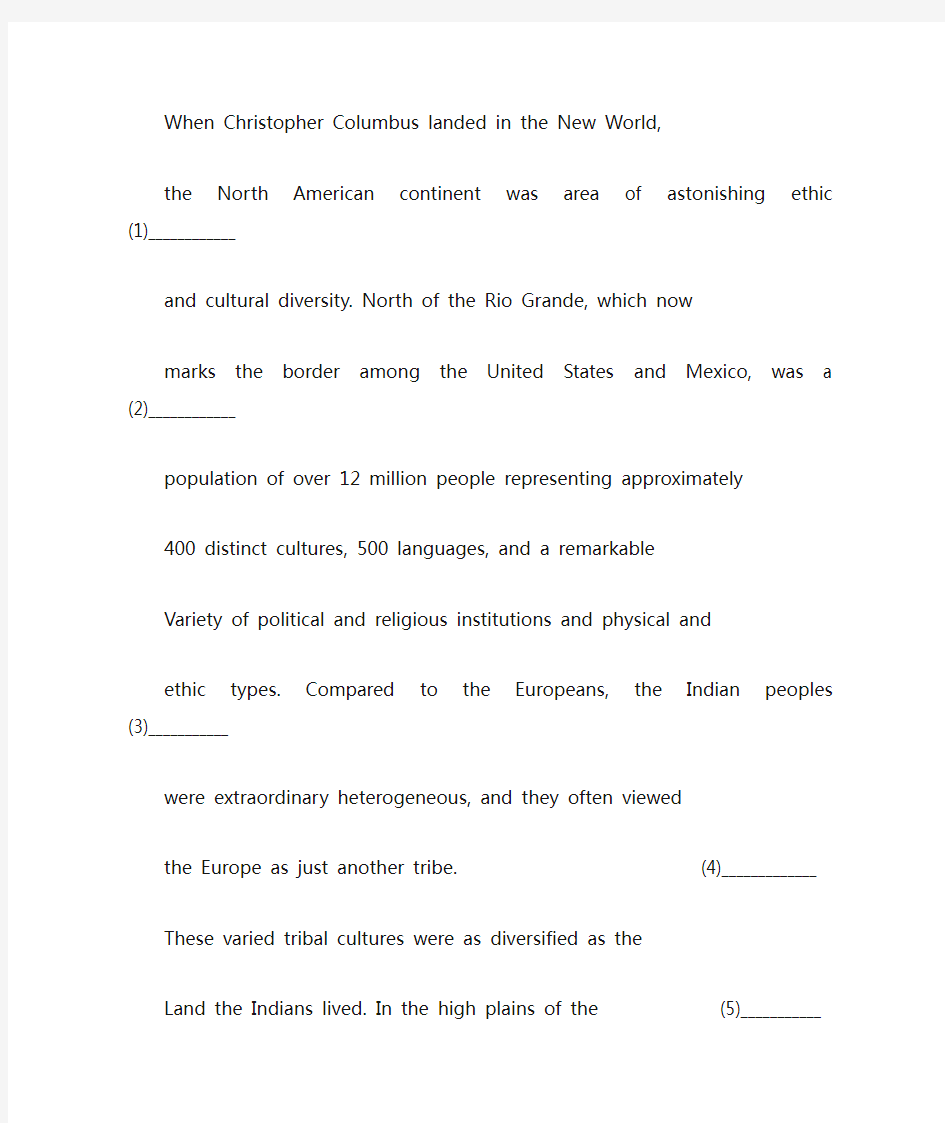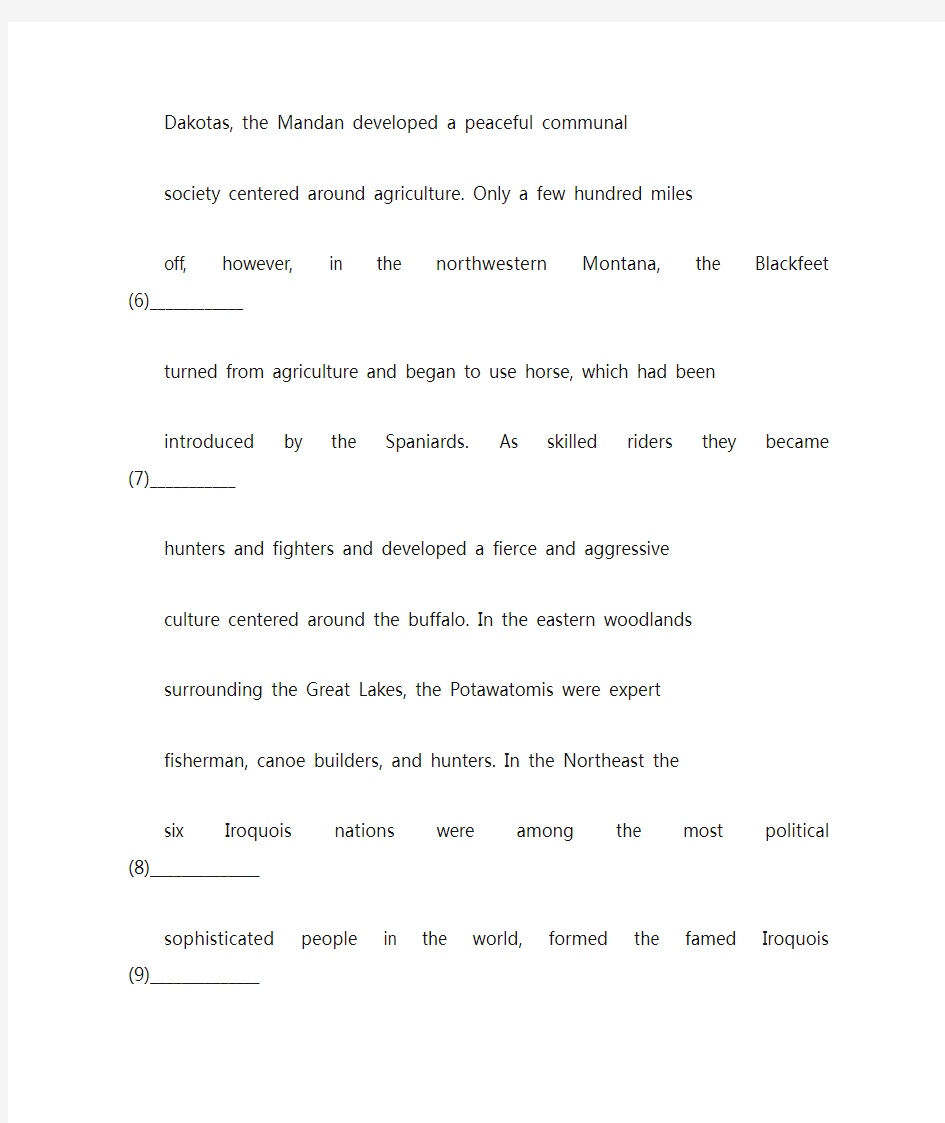proofreading


When Christopher Columbus landed in the New World,
the North American continent was area of astonishing ethic (1)____________
and cultural diversity. North of the Rio Grande, which now
marks the border among the United States and Mexico, was a (2)____________ population of over 12 million people representing approximately
400 distinct cultures, 500 languages, and a remarkable
Variety of political and religious institutions and physical and
ethic types. Compared to the Europeans, the Indian peoples (3)___________
were extraordinary heterogeneous, and they often viewed
the Europe as just another tribe. (4)_____________
These varied tribal cultures were as diversified as the
Land the Indians lived. In the high plains of the (5)___________ Dakotas, the Mandan developed a peaceful communal
society centered around agriculture. Only a few hundred miles
off, however, in the northwestern Montana, the Blackfeet (6)____________ turned from agriculture and began to use horse, which had been
introduced by the Spaniards. As skilled riders they became (7)___________ hunters and fighters and developed a fierce and aggressive
culture centered around the buffalo. In the eastern woodlands
surrounding the Great Lakes, the Potawatomis were expert
fisherman, canoe builders, and hunters. In the Northeast the
six Iroquois nations were among the most political (8)______________ sophisticated people in the world, formed the famed Iroquois (9)______________ confederation, that included the Senecas and the Mohawks (10)_______________ This confederation, with its systems of checks and balances,
Provided a model for the United States constitutions.
Democracy is not a new conception. The ancient Athenians (1)_____________ had a democratic system. Their democracy was the same as
American democracy in many ways. Furthermore, there are (2)_____________ several important differences between their democracy and ours.
The ancient Athenians citizens voted for
their representatives, and they also voted for certain issues. (3)_____________ Moreover, any qualified citizen could become public official. The (4)_____________ ancient Athenians democratic government also protected the
citizens’ right private property, encouraging private business and (5)_____________ supported public education.
A similar system of representative government exists in the
United States. United States citizens vote for their
representatives, they can impeach representatives, too. (6)________________ American citizens also vote on certain important matters. In the
United States, like in ancient Athens, any qualified citizen can (7)______________ become a public official. The government of this country also
protects private property, encourages private business enterprise,
and support public education.
The major difference between these two forms of
democracy is the definition of citizen. In ancient Athens a
citizen was a free man, not a woman and a slave. Women and (8)______________ slaves were largest part of the population; thus, the Athenian (9)_______________ democracy was not broadly representative. In the United States,
however, all American men and women, of all races and
religions, are citizens. Slavery is legal in this country. (10)_____________ therefore, American democracy is more broadly representative.
In brief, democracy is an old and varied concept. In the
Past it meant different things to many different people.
Man has woefully misused the earth’s natural resources down
through the ages. This has been done largely through his ignoring (1)_________
of the consequences, but in the process he has succeeded in laying
wasteful vast expanses of forests and croplands. If our (2)________ extending population is not to suffer from shortages and pollution (3)________
in the future, a great effort must be made to repair some of
the damages already done and to stop more harm from done. A (4)________ few people throughout the world are becoming less aware of our (5)________ past mistakes and are striving to halt this destruction and to revert
to the use of methods from which will give us full use of our (6)______ resources without destroying them. The job may be a long one,
require much study and practice. The most important thing that (7)________ those of us who live in towns or cities can do is to take interest in (8)_______ those problems and find out what is going on around us. Because
much of the land we see is covered up with sidewalks, streets, and
buildings, and this does not mean we are not directly (9)_______ effected by what happens to the water, and atmosphere of our (10)_______ country.
The old-age paternalism of southern Canadians over Eskimos
has died more slowly in the rural villages where Eskimos have
been more reluctant to voice their opinions aggressively. This has
been a frustration in government officials trying to develop local (1)________ leadership among the Eskimos, however a blessing to other de- (2)______ partments whose plans have been received without local obstruction. (3)________
in rural areas the obligations of kinship often ran counter (4)_______ the best interests of the village and potential leaders were restrained
from making positive contributions to the village council.
More recently, therefore, the educated Eskimos have been (5)_______ voicing over the interests of those in the rural areas. They are (6)_______ trying out to persuade the government to recognize the rights of (7)_______ full-time hunters, by protecting their territories from mining and
oil prospectors, for example. The efforts of this active minority
is percolating through to the remoter villages whose inhabitants (8)_______ are becoming increasingly vocal.
Continuing change is inevitable but future development policy
must recognize that most Eskimos retain much of its traditional (9)________ outlook on life. New schemes should focus on resources that
the Eskimos are used to handling, rather than enterprises such as (10)________ Mining.
